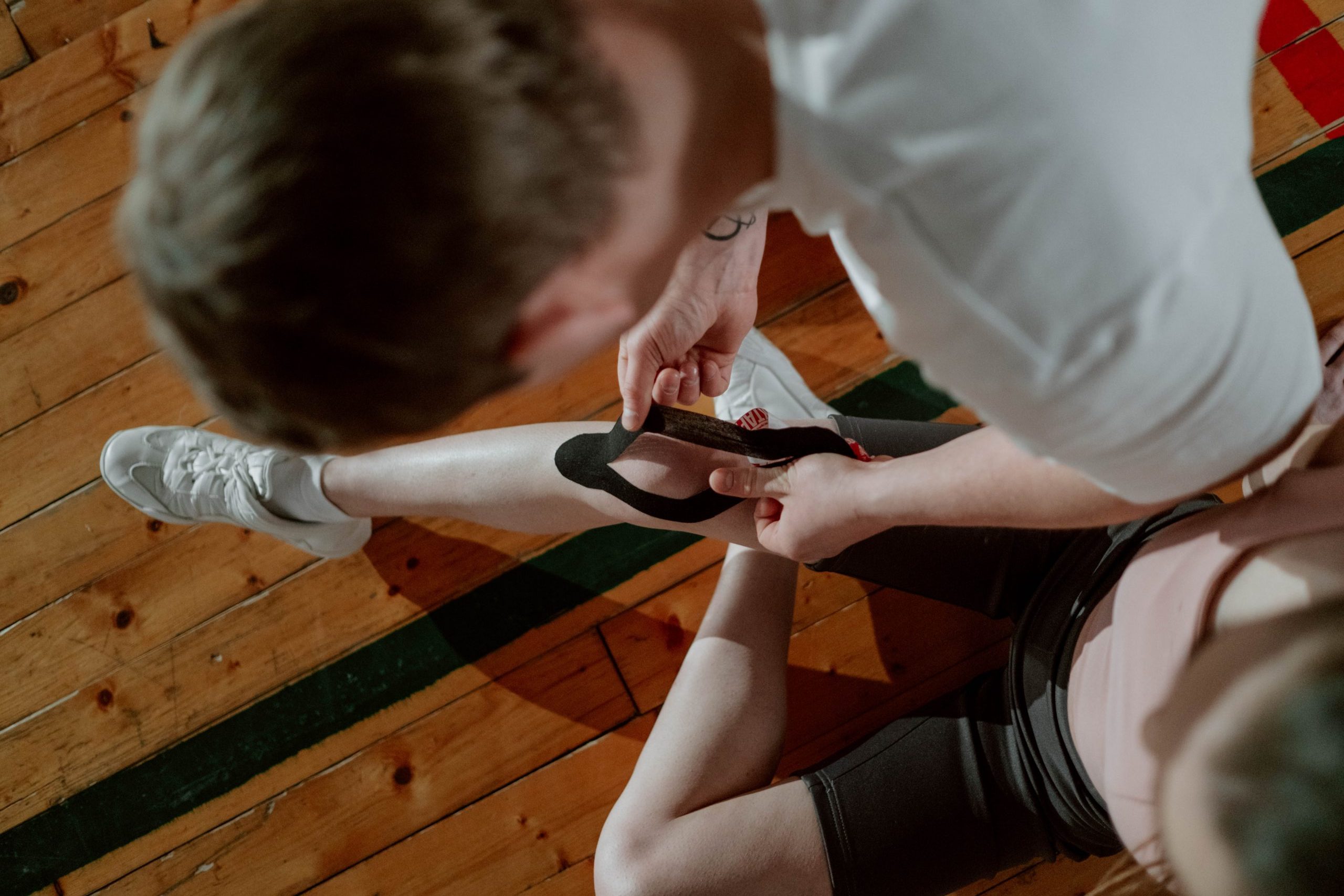Knee pain is all too common. And it’s not surprising. Throughout your life, the knee takes on a lot of wear and tear. This joint helps you walk, run, jump, and more.
In fact, for every additional pound of body weight, the knee takes on about four extra pounds of pressure. Further, deterioration of the knee joints naturally happens as we age.
Yet, either way, it’s safe to say that any kind of pain isn’t fun nor is it ideal — especially when it impacts the knees.
Walking can quickly become problematic, disrupting your daily life and activities. So, what can you do? In this article, we’re going to examine common causes of knee pain, symptoms of knee pain, treatment options, and how physiotherapy can help knee pain.
Understanding Knee Pain: Causes and Symptoms of Knee Pain
The knees provide the legs and body with stability, mobility, and support. Many muscles actually cross over and connect at the knee joint. Any dysfunction or weakness in these muscles may result in knee pain. However, muscular pain isn’t the only culprit leading to discomfort in the knee.
Each knee also has two menisci, which provide this joint with shock absorption and stability.
The knee joints also both have four ligaments, the posterior cruciate ligament (PCL), the anterior cruciate ligament (ACL), the medial collateral ligament (MCL), and the lateral collateral ligament (LCL). The average human body also contains 11 bursae, fluid-filled sacs, around the knee joint. These small sacs help prevent friction between structures of the body.
Pain may occur in the knee due to damage to any of these structural entities. Below, we’ll explore common causes of knee pain in more detail.
Common Causes of Knee Pain
Since the knee is a complex joint, pain can happen due to various reasons. Some of the most common reasons include:
1. Injuries
An injury might happen during sports or other physical activities. Common injuries include patella fractures, ACL injuries, torn meniscus, bursitis, and tendonitis. Many of these injuries happen due to extreme twisting of the knee 9such as pivoting during basketball or soccer) or repetitive overuse (such as increasing your running mileage too quickly).
2. Mechanical Issues
Knee pain might arise due to indirect causes as well. This often means that other areas of the body have come under stress or harm. In turn, the knee may need to compensate to make up for weaknesses or issues elsewhere. For example, hip or foot pain may interfere with your natural gait. This can lead to different mechanics when walking which impact the knee.
3. Arthritis
There are hundreds of types of arthritis. The most common types that impact the knee joint include osteoarthritis, rheumatoid arthritis, and gout.
Common Symptoms of Knee Pain
Common symptoms associated with knee pain include:
- Swelling and stiffness
- The knee is warm to touch
- Popping noises
- Decreased mobility and flexibility
There are also various risk factors that can increase your chances of developing knee pain.
For instance, excess weight can place a ton of pressure on the knee, leading to arthritis. A lack of knee flexibility may also increase your chance of injury. Lastly, working certain occupations or participating in specific sports, such as construction, skiing, and basketball, may increase the amount of stress placed on your knees.
Treatment for Knee and Joint Pain
So, you’re experiencing knee pain — now what?
Usually, treatment varies and depends on the cause of your knee pain. Generally, at the initial onset of pain, using the R.I.C.E. method can help reduce pain and accelerate healing. R.I.C.E. stands for Rest, Ice, Compression, and Elevation.
As soon as pain occurs, rest your knee and ice it. Ensure you place a cloth between your skin and the ice pack. Set a timer for a maximum of 20 minutes, with at least 45 minutes in between each application.
If the pain is severe or persists, book a visit with your doctor. They will likely recommend a physiotherapist to help you make a full recovery.
Physiotherapy for Knee Pain Relief
A physiotherapist’s goal is to help you fully heal and to restore function. Depending on the cause of your knee pain, your physiotherapist will likely use a combination of manual therapy and prescribed exercises to activate your body’s natural healing mechanisms.
Prescribed exercises usually involve a combination of strength and stretching movements to help strengthen the weakened area and increase flexibility.
The number and frequency of visits with your physiotherapist depends on the severity and type of injury or pain you’re experiencing. Usually, your physiotherapist will outline what you can expect in terms of recovery after your initial assessment.
Exercise and Stretches for Knee Pain
So, what are some common exercises and stretches your physiotherapist may recommend for your knee pain? We’ve outlined a few below.
During these exercises, ensure you only go to the point before pain. If pain occurs, stop the exercise and wait to consult with your physiotherapist.
1. Wall Squats
This is a very functional exercise that can help improve strength around the knee, as well as increase flexibility. Depending on your situation, your physiotherapist may prescribe a sit-to-stand exercise first, which involves using a chair to practice standing and sitting.
To perform this exercise:
- Find a free wall.
- Position yourself so that your back is against the wall. For safely, ensure you have a chair or stable object nearby to hold onto if you need it.
- Position your feet so that they are about a step away from the wall.
- Slowly slide down the wall until your thighs are parallel to the floor.
- Pause, then slide back up.
- Do this for 8-10 repetitions and 2-3 sets.
2. Step Ups
This is another functional exercise that can help with movement in your day-to-day life. Step Ups target each side individually. They help strengthen your quadriceps, creating stability at the knee joint.
To perform this exercise:
- Face a stair or step.
- Place one foot on the step.
- Bend your knee and step up, raising your opposite foot off the floor and extending your knee slightly.
- Pause while your opposite foot is off the floor, then lower it back down.
- Do this for 8-10 repetitions and 2-3 sets. Don’t forget to do each side!
3. Straight Leg Raises
Straight Leg Raises also target the quadriceps. Usually, you’ll start this exercise without weight. As you improve, you may add ankle weights to further increase strength.
To perform this exercise:
- Lay face up on a yoga mat or comfortable spot.
- Bend your left leg and plant your foot on the floor.
- Keeping your right leg straight (but without locking the knee), slowly raise your leg straight up.
- Pause, then slowly lower.
- Repeat for 8-10 repetitions and 2-3 sets. Make sure you do each side.
4. Glute Bridges
The glute bridge helps strengthen your glutes, as well as engages the adductors of the leg. The adductor muscles help stabilize the knee joint.
For this exercise:
- Lay face up on a comfortable surface.
- Bend both your knees and plant your feet flat on the ground.
- Place a pillow or block in between your knees (in a spot that doesn’t cause pain) and gentle squeeze.
- Slowly lift your buttocks and hips up and off the ground.
- Pause at the top.
- Slowly lower.
- Perform 8-10 repetitions for 2-3 sets.
5. ITB Stretch
The IT Band (iliotibial band) can become irritated and tight due to overuse, such as during running movements. Stretching it can offer a ton of relief and help improve flexibility in the legs.
Here’s how to do this one:
- Stand tall facing a table or bed.
- Place your hands on the table or bed, and cross your right leg behind your left.
- Slowly lean to your right side, protruding your hip out and making a half moon shape with your body. Use the table or bed for balance.
- You should feel a stretch down the side of your right leg. When you do, hold for 20-30 seconds.
- You can repeat this stretch 2-3 times a day.
Say Goodbye to Knee Pain for Good
If you’re experiencing knee pain, don’t hesitate to reach out to our compassionate and caring team at Corydon Physiotherapy. Our ultimate goal is to help each and every patient bounce back after injury and pain, and get back to enjoying the activities they love.
Book your appointment today by calling us at (204) 925-0380, emailing us at corydonp@mymts.net, or by using our self-serve online booking system.




